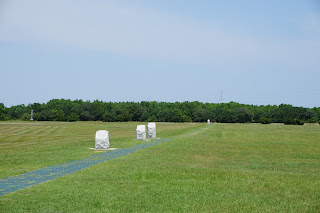My grandsons and I had another Adventure with MaMa Berry day. We toured the Wright Brothers National Memorial in Kill Devil Hills, NC. If you haven't been, put it at the top of your bucket list!
A few thoughts. First, today was a scorching 102 degrees, but the breeze was delightful. It evaporated the perspiration and was cooling. However, it still was miserable! However, I chuckled to myself thinking the Wright brothers definitely were on to something when they picked the area for their flight. It definitely was breezy.
Second, the sand dune may have been isolated in 1903, but it sits in the middle of housing developments, highways, and commercial businesses. Their patent surely would have fallen to industrial espionage if today had been the historic flight.
Third, I always thought the historic flights took off from atop the sand dune. I learned the sand dune was the origin of their glider flights. They perfected their designs with the information they learned during those early experiments. The four powered flights of December 17, 1903, took place on the sand in front of the dune. Orville was the pilot for the first three; Wilbur was the pilot for the fourth and longest flight of the day. I also learned Wilbur and Orville flipped a coin to see who would pilot the airplane first. Wilbur won, but crashed the plane during the December 14, 1903, attempt.
 |
| The bronze sculpture depicts Wilbur Wright as he releases the wing of the Wright Flyer when Orville goes airborne. |
The Memorial consists of a visitors center, a First Flight airstrip, two reconstructed buildings where Orville and Wilbur worked and lived while in NC, a granite boulder where the first flight left the ground, four markers that indicate the distance, paths, and landings of each of the day's four flights, a 60-foot monument atop the 90-foot sand dune, and a recreated scene of the first flight.
 |
Orville Wright pilots the first heavier-than-air, powered and controlled airplane December 17, 1903, at Kill Devil Hills, NC.
|
The original Wright Flyer is in the National Air and Space Museum in Washington, D.C.
 |
| Wilbur Wright runs alongside the Wright Flyer to steady the wing until Orville lifts the plane off the rail. |
 |
| The federal government erected a 60-monument in honor of the historic flight atop the 90-foot sand dune. |
 |
| My grandsons were curious as to where the pilot sat. They were surprised to see Orville Wright was on his stomach during the flight. |
 |
| Orville Wright concentrates as he steers the plane in 27-mph winds. He didn't want to make the same mistake Wilbur had made three days earlier when, after leaving the rail, he oversteered, climbed too steeply, stalled the engine and dove into the sand. |
 |
Three of the five witnesses to the first flight: Left to right, Johnny Moore, a 16-year-old who lived his entire life on the Outer Banks and worked as a hunting and fishing
guide; Adam Etheridge, a member of the US Life-Saving Service at Kill Devil Hills. A life-long friend of the Wright brothers, he took care of their camp buildings when they left the area in 1903; W.C. Brinkly, a lumberman from Manteo who happened to be visiting the Life-Saving Station when the Wright brothers asked them to help with the flight.
|
 |
| Willis Dough, also a member of the US Life-Saving Station, helped the Wright brothers in their 1908 flights when they returned to Kitty Hawk the last time together. |
 |
| The life-size bronze and stainless steel flyer weighs 10,000 pounds. |
 |
| John Daniels from the lifesaving station snapped the shutter on a preset camera owned by the Wright brothers and captured the image of the airborne aircraft. |
 |
| The Park Service recreated the historic day in this bronze and stainless steel life-size sculpture. |
 |
| Two of my grandsons stand in front of the granite marker that indicates the spot where the Wright Flyer went airborne. Notice the rail in front of the marker. The rail was a crucial element of the takeoff. |
 |
| The Wright brothers launched their plane four times December 17, 1903. The granite markers indicate the path, distance, and landing spot of each flight. The first flight lasted 12 seconds and flew 120 feet. The second flight lasted 12 seconds and flew 175 feet. The third flight lasted 15 seconds and flew 200 feet. The fourth flight lasted 59 seconds and flew 852 feet. |
















No comments:
Post a Comment